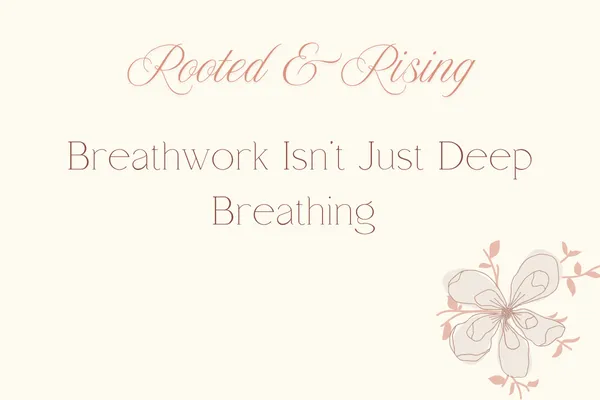
Breathwork Isn’t Just Deep Breathing
If you had told me a few years ago that breathwork would be a core part of how I care for my body, my brain, and my spirit—I probably would’ve smiled politely and thought, "maybe for you, but that is not really my thing."
Because for most of my life, I thought breathwork just meant “take a deep breath when you're stressed.” You know, the kind of advice you get when you're about to cry in a public place or you’ve just spilled coffee on your white shirt before a big meeting. “Just breathe…” they say. And sure, it helps a little.
But breathwork—real, intentional breathwork—is so much more than a quick fix for a stressful moment. It’s not just woo-woo, or spiritual fluff, or something reserved for monks on a mountaintop or wellness influencers in matching loungewear.
It’s biology. It’s biomechanics. And honestly, it’s a bit of a miracle.
See, our bodies weren’t designed for how we live now. We sit most of the day—at desks, in cars, on the couch. We scroll. We stream. We stare at screens. We rarely move like our ancestors did—who walked, gathered, squatted, stood, and rested naturally throughout the day.
On top of that, modern life is loud. It’s packed with expectations and to-do lists and constant comparisons. Who has the bigger house? The better body? The more put-together life? We’re bombarded with messages that tell us to hustle, achieve, prove ourselves, and accumulate all the shiny things to feel like we’re “enough.”
This high-stress, low-movement lifestyle literally reshapes how we breathe.
Instead of full, steady, relaxed breaths that fully engage the diaphragm, we end up taking short, shallow sips of air—often through our mouths, high up in the chest, activating our stress response. And because breath and nervous system go hand in hand, our bodies interpret this style of breathing as a message: “Something is wrong. Stay alert. Be on guard.”
So we stay anxious. We stay tense. We brace ourselves for danger that often isn’t there.
But we can rewire all of that. And it starts with something as simple as your breath.
A daily breathwork practice is like giving your body a manual update—reminding it how to breathe in a way that supports safety, presence, and balance. It retrains the mechanics of your breathing, gently nudging your nervous system into calm, regulated rhythms. It helps you feel different in your body—less on edge, more grounded, more at home in yourself.
It’s not magic. But it feels like it sometimes.
You don’t need special tools or a 90-minute meditation session to get started. Breathwork isn’t about doing something complicated or “getting it right.” It’s about returning to something simple that your body was always meant to do well—but over time, under the current stress of life, we learned a less efficient way to breathe. Most of us have developed shallow, rushed, or tight breathing patterns without even realizing it. This practice is an invitation to slow down. To relearn how to breathe in a way that brings ease, not tension. Calm, not chaos. Presence, not panic.
So what does breathwork actually look like in everyday life?
I start most of my clients on a program by practicing the 3-part breath.
It’s simple, powerful, and surprisingly eye-opening. Because for something we do all day every day, most of us have no idea how we’re breathing—or what it’s doing to us.
This practice brings awareness back to the mechanics of your breath. It’s not about inflating your belly like a balloon or taking exaggerated gulps of air. It’s about slowing down just long enough to feel your breath move through your body—and reminding your body how it was designed to breathe.
Start by finding a comfortable spot. Sit on a chair, the floor, your couch—just somewhere you can feel supported and upright. You could even lay down if that works better for you, as long as your spine is straight. Rest your hands gently on your lower ribs or belly to help guide your attention.
Close your eyes (if you feel comfortable) and take a slow inhale.
First, direct the breath downward—toward your lower ribs and belly.
You don’t need to force your belly to stick out like you've swallowed a watermelon. Think more about sending the breath into the lower lungs, allowing the lower ribs to expand softly outward. Like an umbrella opening gently. This is the base of your breath—your foundation.
Then, let the breath move up into the midsection—your side ribs and diaphragm. Feel your ribcage widen just slightly, like it’s making space.
Finally, let the breath rise into your chest—the collarbones lifting a little at the top of the inhale.
Belly - Ribs - Chest. That’s one full inhale.
Now, exhale slowly and passively.
Don’t push it. Just let your body soften and release. Imagine your muscles melting, tension sliding off your shoulders, your face, your jaw. Let gravity help.
Do this 10 times. Slowly.
No rush. No pressure. Just you, your breath, and your body.
And as you breathe, here’s the real magic:
You’ll start to feel yourself again.
We spend so much of our day ignoring what we feel—rushing past tension, stuffing down emotions, pushing through discomfort because “we don’t have time for that right now.” But the truth is, when we disconnect from our sensations, we also disconnect from ourselves. And that disconnection? It builds. It festers. And eventually, it shows up as dis-ease.
Breathwork is a way back. A daily check-in. A reset button.
It doesn’t fix everything overnight, but it does start to shift something subtle—and powerful. It invites your nervous system to stop bracing and start softening. It shows your body that it’s safe to be here, now.
So give it a try. Just 10 breaths.
Start at the belly.
Then the ribs.
Then the chest.
Slow exhale.
Repeat.
Then? Notice.
How do you feel? Lighter? Clearer? More grounded? A little more you?
Maybe even jot it down. Journaling after a breath session can help you track your progress, notice patterns, and stay connected to your practice. Or, if you're curious to go deeper, seek out a breath coach who can guide you through the next layers of this healing process.
Because this—this little practice?
It’s not just breathwork.
It’s soul work.
And you’re more than worth the time it takes.
